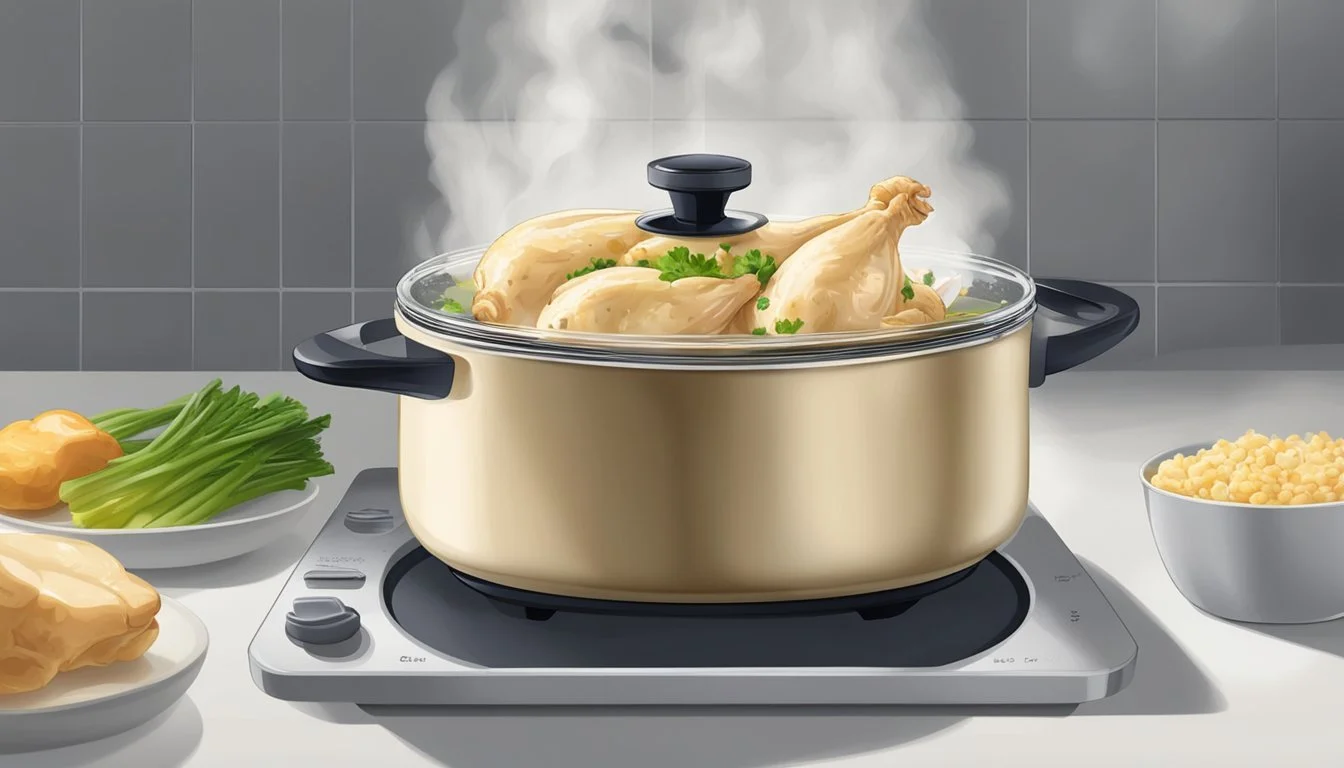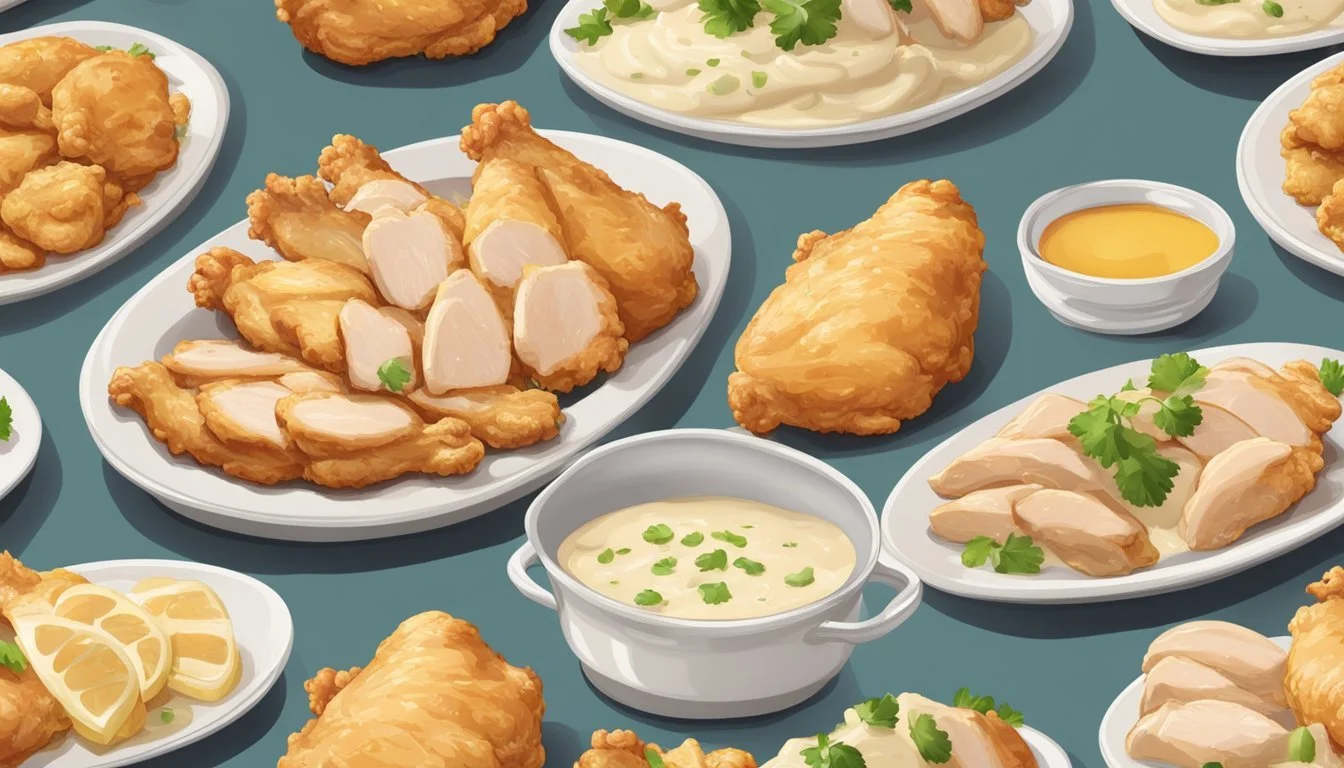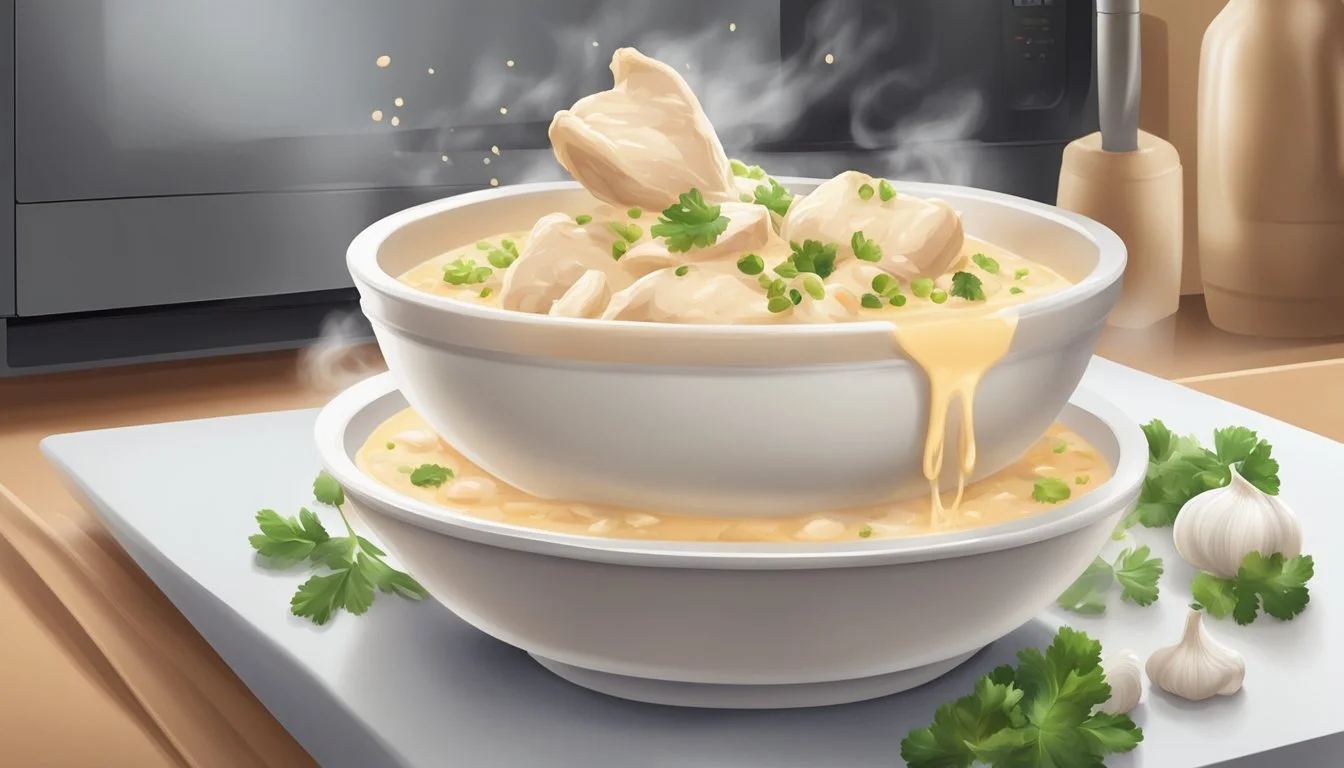Best Way to Reheat Creamy Garlic Chicken
Preserving Flavor and Richness
Reheating creamy garlic (What wine goes well with garlic?) chicken presents a challenge to many home cooks—they want to ensure the dish retains its rich flavor and creamy consistency without becoming dry or losing its savory garlic essence. The key to successfully reheating leftover chicken lies in the method chosen and attention to details such as temperature and coverage. Careful reheating can rejuvenate the creamy garlic sauce, allowing it to cling to the tender chicken, which can relish the taste as if freshly made.
The best methods to reheat creamy garlic chicken typically involve gentle heat to avoid separating the sauce and ensuring the chicken doesn't dry out. Utilizing tools like the oven or stovetop can result in a meal that's as enjoyable as the original dining experience. Protecting the moisture during the reheating process is crucial, and techniques like covering the chicken with foil or a lid can trap steam and keep the chicken moist. Steaming can also play a role, adding moisture back to the dish without making it soggy.
When reheating chicken, achieving and maintaining a safe internal temperature is of prime importance. Leftover chicken should be heated to an internal temperature of 165°F to ensure it's safe to eat. By monitoring the temperature with a meat thermometer and using these recommended practices, one can restore the sublime flavors of creamy garlic chicken, making leftovers a coveted meal rather than a last resort.
Understanding Reheating Basics
Proper reheating of creamy garlic chicken is critical to both food safety and the dish’s dining appeal, ensuring that it maintains its rich flavor and moist texture while eliminating harmful bacteria.
Food Safety Considerations
When reheating leftovers, it's vital to address food safety to prevent the growth of bacteria. Cooked chicken should be refrigerated within two hours of cooking and consumed within three to four days. Before reheating, if the chicken was frozen, it needs to be defrosted safely in the refrigerator. Always reheat to an internal temperature of 165°F, measured with a meat thermometer.
Maintaining Moisture and Texture
The key to keeping reheated creamy garlic chicken rich and moist lies in adding a small amount of liquid. For best results, one can add a bit of oil, butter, or chicken broth to avoid dryness. Covering the chicken during the reheating process helps to retain moisture and to preserve the texture and flavor of the dish.
Choosing the Right Reheating Method
There are several methods for reheating, each with its own benefits:
Oven method: Reheat at a low temperature, like 350°F, to keep the chicken tender.
Microwave method: Short and fast, but may need additional liquid to maintain moisture.
Stovetop reheating: Allows better control over the temperature and adds moisture easily.
Air fryer: Good for achieving a crispy exterior, but it must be watched closely to prevent drying out.
Determining Reheating Times and Temperatures
Reheat creamy garlic chicken slowly and evenly to avoid overheating. The process varies depending on the method:
Method Temperature Time Texture Result Oven 350°F 10-15 mins Evenly warmed Microwave High 1-2 mins Quick, less even Stovetop Medium 5-7 mins Controlled reheating Air fryer 375°F 3-4 mins Crispy exterior
Always preheat the reheating device and check the internal temperature to ensure safety and quality.
Reheating Creamy Garlic Chicken in Various Appliances
Choosing the right reheating method can make a significant difference in preserving the taste and texture of creamy garlic chicken. Here are techniques tailored for various appliances.
Oven Reheating Technique
To reheat chicken in the oven and maintain its moisture:
Preheat the oven to 350°F.
Place the chicken in a baking dish and add a few tablespoons of water or chicken broth to keep it moist.
Cover the dish with aluminum foil to prevent the sauce from drying out.
Heat for 20-25 minutes or until an internal temperature of 165°F is reached.
Microwave Reheating Steps
For a quick reheating method in the microwave:
Transfer the chicken to a microwave-safe dish.
Cover with plastic wrap or a damp paper towel to trap steam and keep the chicken moist.
Reheat on medium power in 30-second intervals, checking for an even temperature of 165°F.
Stovetop Reheating Process
Using the stovetop effectively reheats and keeps the creaminess intact:
Place the chicken in a skillet or frying pan with a little liquid (broth or water).
Cover and simmer on a low-medium heat.
Stir occasionally until the chicken reaches the safe internal temperature.
Alternative Reheating Methods
Other appliances offer convenience and can be effective too:
Air Fryer: Ideal for reheating fried chicken to keep the exterior crisp. Reheat at 375°F for a few minutes, checking frequently.
Steamer: Steam leftover chicken breasts (What wine goes well with chicken breast?) to keep them moist; monitor closely to avoid overcooking.
Each appliance has its own set of advantages, and using the appropriate reheating technique will help preserve the creamy, rich flavors of garlic chicken.
Special Considerations for Different Chicken Cuts
When reheating creamy garlic chicken, different cuts require specific methods to preserve the dish's richness and flavor. Boneless and skinless pieces, breaded and braised cuts, as well as thighs and wings, each have their own set of considerations.
Reheating Boneless and Skinless Pieces
Boneless and skinless chicken breasts are prone to drying out if not reheated carefully. To retain moisture:
Preheat the oven to 350°F.
Place chicken in an oven-safe dish and add a few tablespoons of chicken broth or the original sauce to it.
Cover with foil and heat for about 10 minutes or until an internal temperature of 165°F is reached.
Handling Breaded and Braised Cuts
For breaded creamy garlic chicken:
Preheating the oven to a higher temperature, around 400°F, will help retain the crispiness.
Placing the breaded cut on a wire rack atop a baking sheet allows for even heating.
Bake for 10-15 minutes, checking to avoid overcooking.
Braised chicken cuts should be reheated in the same liquid they were cooked in to maintain their succulence. A slow reheat in a covered pot over the stove works best.
Strategies for Chicken Thighs and Wings
Chicken thighs and wings retain their flavor and juiciness better due to higher fat content. To best reheat chicken thighs and wings:
Preheat the oven to 375°F.
Arrange the chicken on a baking sheet and cover lightly with foil.
Heat for about 15 minutes, then remove the foil and heat for another 5 minutes to crisp up the skin.
Enhancing Flavor and Crispiness Post-Reheating
After reheating creamy garlic chicken, one can further enhance its flavor and restore its appealing texture with a few thoughtful steps. These include the judicious use of liquids and fats, techniques to achieve a crispy exterior, and specific seasoning and serving recommendations.
Using Liquids and Fats Effectively
To maintain the richness of creamy garlic chicken leftovers, one should carefully manage the use of liquids and fats. A small amount of chicken broth can be added to the dish before reheating to keep the chicken moist. Alternatively, a drizzle of olive oil or a pat of butter can enrich the flavors and contribute to a satisfying mouthfeel. Here's how one might integrate them:
Chicken Broth: Add a splash just to coat the bottom of the dish; the broth will produce steam while reheating, which helps to keep the chicken tender.
Olive Oil: Drizzle lightly over the chicken to add a layer of richness.
Butter: Dotting the chicken with small portions of butter before reheating will infuse it with additional richness and flavor.
Achieving a Crisp Exterior
For those desiring a bit of a crunch on their creamy garlic chicken, achieving a crispy skin post-reheating is key. To do this, one might:
Preheat the oven or skillet to a high temperature before adding the chicken.
Avoid covering the chicken with aluminum foil as this will trap moisture and soften the skin rather than crisping it.
Use a Wire Rack: If using an oven, place the chicken on a wire rack over a baking sheet. This allows air to circulate around the chicken, evenly crisping the exterior.
Seasoning and Serving Tips
Once the creamy garlic chicken is reheated, adding a final touch with seasoning can elevate its flavor profile. Here are some tips:
Salt and Pepper: A simple seasoning of salt and pepper can be applied after reheating to enhance the natural flavors of the chicken.
Fresh Herbs: Garnish with fresh herbs such as parsley or thyme to add a vibrant note to the dish.
Serving the chicken promptly ensures that it retains the ideal texture and temperature, allowing for the best possible dining experience.
Storing and Freezing Reheated Chicken
When it comes to preserving the quality of creamy garlic chicken, proper storage methods are essential. After reheating, one may choose to freeze or refrigerate any leftovers to extend their shelf life.
Refrigerating:
To refrigerate, place the reheated chicken in an airtight container.
It's best enjoyed within 3-4 days to uphold food safety and maintain flavor.
Freezing:
For freezing, the chicken should be cooled completely to avoid ice crystal formation.
Wrap it tightly in foil or plastic wrap before placing it in a freezer bag or container.
If stored correctly, creamy garlic chicken has a freezer shelf life of about 4 months.
Thawing:
When ready to consume, thaw the chicken slowly in the refrigerator for optimal texture and taste.
Food Safety Tips:
Always ensure reheated chicken reaches an internal temperature of 165°F.
Never refreeze chicken that has already been reheated as this can compromise food safety and quality.
Method Container Shelf Life Temperature Refrigerate Airtight container 3-4 days Below 40°F (4°C) Freeze Freezer-safe wrap Up to 4 months 0°F (-18°C) or below
By following these guidelines, one can safely extend the enjoyment of creamy garlic chicken while ensuring its richness is preserved.
Frequently Asked Questions
In this section, readers will find succinct, expert advice for ensuring their creamy garlic chicken remains moist and delicious when reheated, while also adhering to food safety guidelines.
How to Reheat Chicken Without Drying It Out
To maintain the moisture of chicken, one should reheat it gently. Using an oven, set the temperature to 350°F, place the chicken in an oven-safe dish, and add a bit of liquid, like broth or water. Cover the dish with foil to retain moisture. It's ready when it reaches an internal temperature of 165°F.
How Long to Reheat Chicken for Optimal Safety
Reheating leftovers should be done until they reach the safe internal temperature of 165°F as measured with a food thermometer. This typically takes about 15-20 minutes in an oven preheated to 350°F. Always check at the thickest part of the chicken to ensure complete reheating.
Can You Reheat Chicken in Its Original Sauce?
One can definitely reheat chicken in its original sauce to preserve flavor and moisture. Place the chicken and sauce in a pan and heat on the stove over medium heat, stirring occasionally. Alternatively, bake in an oven at 350°F, covered, until the chicken reaches the necessary internal temperature of 165°F.
Best Practices for Reheating Roasted Chicken
For roasted chicken, (What wine goes well with roasted chicken?) the goal is to warm it without losing its succulence or creating a rubbery texture. One should:
Preheat the oven to 350°F.
Add a small amount of water or broth to the dish with the chicken to maintain moisture.
Cover the dish with foil.
Heat until internal temperature reaches 165°F.
If a crispier skin is desired, remove the foil for the final few minutes of reheating.
It's essential to avoid direct high heat which can overcook the chicken, and always check the internal temperature for safety.






